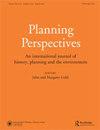An analysis of the small planned towns built for the workers of the Badajoz Plan dams in Spain
IF 0.9
3区 历史学
0 ARCHITECTURE
引用次数: 0
Abstract
ABSTRACT One of the most interesting urbanistic ensembles of the twentieth century in Spain is the towns planned and built near the large dams to provide services for their construction and operation. In the Province of Badajoz four very large dams were built by the central administration, which also promoted the construction of workers’ towns in the surrounding area. These towns are unique components of the rural Extremadura landscape. Without them, the dams could not have been built in the Spain of Franco’s dictatorship, and they are a testimony to action carried out in the territory, how work was organized and how the integrating relationship of buildings and nature was understood as a particular conception of the landscape. This article first reviews the historical context, both from the point of view of planned urbanization concerning company towns and the Badajoz Plan itself. The villages are describe based on field visits and documents found in the AGA archives in Alcala de Henares and the offices of the Guadiana Water Board in Mérida; lastly, the data are analysed, and some conclusions are arrived at.为西班牙巴达霍斯大坝工人建造的小城镇规划分析
本文章由计算机程序翻译,如有差异,请以英文原文为准。
求助全文
约1分钟内获得全文
求助全文
来源期刊

Planning Perspectives
Multiple-
CiteScore
1.50
自引率
12.50%
发文量
85
期刊介绍:
Planning Perspectives is a peer-reviewed international journal of history, planning and the environment, publishing historical and prospective articles on many aspects of plan making and implementation. Subjects covered link the interest of those working in economic, social and political history, historical geography and historical sociology with those in the applied fields of public health, housing construction, architecture and town planning. The Journal has a substantial book review section, covering UK, North American and European literature.
 求助内容:
求助内容: 应助结果提醒方式:
应助结果提醒方式:


